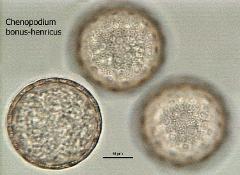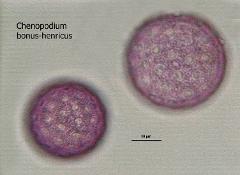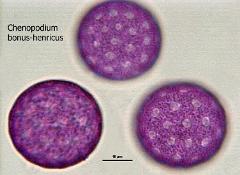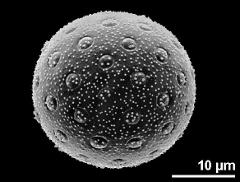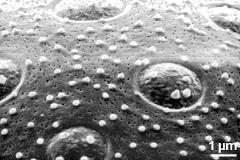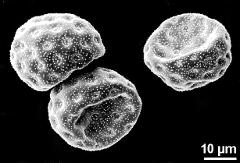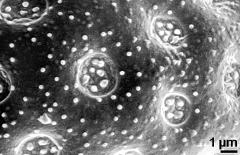Chenopodium bonus-henricus
Taxonomy: Angiospermae, Caryophyllales, Amaranthaceae, Chenopodium
Links: http://flora.nhm-wien.ac.at/Seiten-Arten/Chenopodium-bonus-henricus.htm
Published: 2020-10-28
Pollen Description
Shape, Size and Aperture
pollen unit: monad, dispersal unit and peculiarities: monad, size (pollen unit): medium-sized (26-50 µm), size of hydrated pollen (LM): 31-35 µm, shortest polar axis in equatorial view (LM): -, longest polar axis in equatorial view (LM): -, shortest diameter in equatorial or polar view (LM): 31-35 µm, longest diameter in equatorial or polar view (LM): 31-35 µm, pollen class: porate, polarity: isopolar, P/E-ratio: isodiametric, shape: spheroidal, outline in polar view: circular, dominant orientation (LM): polar, P/E-ratio (dry pollen): -, shape (dry pollen): cup-shaped, outline in polar view (dry pollen): irregular, infoldings (dry pollen): -, aperture number: >6, aperture type: porus, aperture condition: pantoporate, porate, aperture peculiarities: pantoaperturate, aperture membrane ornamented
Ornamentation and Structure
LM ornamentation LM: scabrate, verrucate, gemmate, nexine: -, sexine: -, SEM ornamentation SEM: perforate, microechinate, suprasculpture SEM: -, TEM tectum: -, infratectum: -, foot layer: -, endexine: -, intine: -, wall peculiarities: -, supratectal element: -
Miscellaneous
pollen coatings: -, reserves in cytoplasm: -, cell number: -, Ubisch bodies: -
Author(s) of diagnosis: Halbritter, Heidemarie; Heigl, Helmut
Pictures
Picture legend
- hydrated Pollen - fresh, glycerine, unstained, photographer: Heigl, H.
- hydrated Pollen - fresh, glycerine, ruthenium red, photographer: Heigl, H.
- hydrated Pollen - fresh, glycerine, ruthenium red, photographer: Heigl, H.
- hydrated pollen grain - fresh, DMP & critical point dried, photographer: Halbritter, H.
- apertures and exine surface - fresh, DMP & critical point dried, photographer: Halbritter, H.
- dry pollen grains - dry, photographer: Halbritter, H.
- apertures of dry pollen grain - dry, photographer: Halbritter, H.
Literature
- (1969) Development and histochemistry of the endothecium in the anthers of in vitro grown Chenopodium rubrum L. Bot Gaz 130: 10-22
- (1998) Preparing living pollen material for scanning electron microscopy using 2,2-dimethoxypropane (DMP) and criticalpoint drying. Biotechnic Histochem 73: 137–143
Copyright and Citation
Cite this publication as:
Halbritter H., Heigl H. 2020. Chenopodium bonus-henricus. In: PalDat - A palynological database. https://pc8.botanik.univie.ac.at/pub/Chenopodium_bonus-henricus/303799;jsessionid=83E1E8903C1A9299E5E28DB2CBD326D1; accessed 2025-01-10

